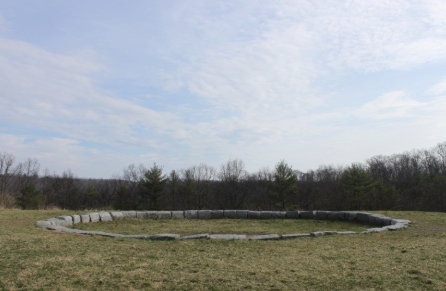
Peace Chapel
The Elizabeth Evans Baker Peace Chapel is located on the Baker-Henry Nature Preserve at Juniata College. Elizabeth Evans Baker commissioned the chapel and acclaimed architect Maya Lin, who designed the Vietnam Veterans Memorial in Washington, D.C., designed the Peace Chapel. Construction took place in 1989 and the formal dedication came on October 14, 1990. The chapel reflects both Juniata College’s and Elizabeth Evans Baker’s commitment to peace and serves as a focal point for both college and community activities.
Elizabeth Evans Baker was a key benefactor to Juniata College’s Baker-Henry Nature Preserve and Baker Institute for Peace and Conflict Studies. Along with her husband, John Baker, a 1917 graduate of Juniata who later served on the Juniata College Board of Trustees, Elizabeth Baker helped the college buy the Metz poultry farm in Oneida Township in 1969. The land consisted of 170 acres of forest and fields located on a ridge on Warm Springs Avenue behind East Houses and was set aside by the Board of Trustees for educational and recreational use. In 1974, John and Elizabeth Baker were the primary benefactors in the creation of Juniata College’s peacemaking program; the program was renamed the Baker Institute for Peace and Conflict Studies in the spring of 1989.
The creation of the Peace Chapel took several decades to come to realization. Elizabeth Evans Baker first thought of creating a peace chapel for Juniata College during the purchase of the nature preserve; she was impressed by the land’s “edenic” scenery and suggested that a small building for meditation be built on the ridge. Due to concerns about practicality, the idea was shelved for nearly twenty years until 1985, when Andrew Murray, the then director of the Baker Institute, suggested that an open air chapel be created instead. In 1987, Elizabeth Evans Baker consulted with a local architectural firm in State College to begin the design process. However, their designs were considered too overtly artistic and religious, and their proposal was rejected.
It was then that Baker thought of Maya Lin. John and Elizabeth Baker knew Maya Lin on a personal basis. From 1945 to 1961, John Baker had served as the president of Ohio University where Lin’s parents were both professors; her father and John Baker were close friends. The Bakers met with Lin in the fall of 1987 to discuss the Peace Chapel project. Lin visited the site the following spring and accepted the Bakers’ commission. Lin completed the chapel’s design in 1988 and construction began in 1989, a process that lasted approximately six months and was supervised by college maintenance staff.
The completed Peace Chapel’s design reflected Elizabeth’s desire for an ecumenical place for meditation that did not interfere with its natural surroundings. The main area consists of a circle forty feet in diameter, composed of fifty-three salt-and-pepper colored granite blocks set at slightly different heights that surround a shallow depression in the earth. A second circle is located in a small cluster of trees on a higher hilltop several yards away. This circle is made of polished bluestone and is four feet in diameter. The larger circle is meant for group meditation, while the smaller circle is meant for private meditation; correspondingly, the public circle is visible from the private circle, while the private circle is not visible from the public one. Twenty-five rectangular stone slabs set flush with the earth lead up to the main circle of stones 500 feet down the hill from the Peace Chapel’s access road. The use of circles in the design represents a nondenominational approach, as its symmetrical value equalizes all participants. In order for the chapel to not intrude on its natural setting, Lin intended for the grass to grow up around the stones of the main circle, and for moss to grow over the smaller circle, so that the two sites would essentially disappear from sight.
The chapel has been the venue for many college and community activities since its dedication in 1990 and has received widespread recognition. In 1994, the chapel was featured in the Academy Award winning documentary, “Maya Lin: A Strong Clear Vision.” In 2000, the college began an initiative, directed by Dr. Andrew Murray, to hold a prayer ceremony for peace every day of the first year of the new millennium at the Peace Chapel; approximately 1,000 people participated in the program, including people from the Jewish, Christian, Muslim, Baha’i, and Hindu faiths, and coming as far away as State College. Easter sunrise services, services for the United Nations International Day of Peace, Earth Day activities, and weddings and memorial services have all been held at the Peace Chapel. Because of the vision of a single woman, the Elizabeth Evans Baker Peace Chapel has become a source of pride for Juniata College and the Huntingdon community.
Lisa Bean
1,145 words
Bibliography
Cummings, Meredith. “College’s Chapel Designed by Lin.” Altoona Mirror. Altoona, November 28, 1996.
Daniels, Marta. Peace Is Everybody’s Business: Half a Century of Peace Education with Elizabeth Evans Baker. Huntingdon: Juniata College, 1999.
Kaylor, Earl C. Juniata College: Uncommon Vision, Uncommon Loyalty: The History of an
Independent College in Pennsylvania Founded by the Brethren 1876-2001. Huntingdon:
Juniata College, 2001.
Truth Sets Free: Juniata Independent College in Pennsylvania, Founded by the Brethren, 1876: A Centennial History. A. S. Barnes, 1977.
Langmead, Donald. Maya Lin : a Biography. Santa Barbara, Calif.: Greenwood, 2011.
Lin, Maya Ying. Maya Lin: Topologies. Southeastern Center for Contemporary Art, 1998.
Mock, Freida Lee. Maya Lin: A Strong Clear Vision. DVD. Docurama, 2003.
Smith, Kimberly K. “Baker Peace Chapel Hosts 2000 Prayers for Peace.” The Daily Herald. Tyrone, February 12, 2000.
“Vietnam Memorial Architect Presents Keynote Address.” Juniata College Bulletin, winter 1990.
“‘Wall’s’ Creator Unveils Peace Chapel.” The Daily News. Huntingdon, October 16, 1989.
